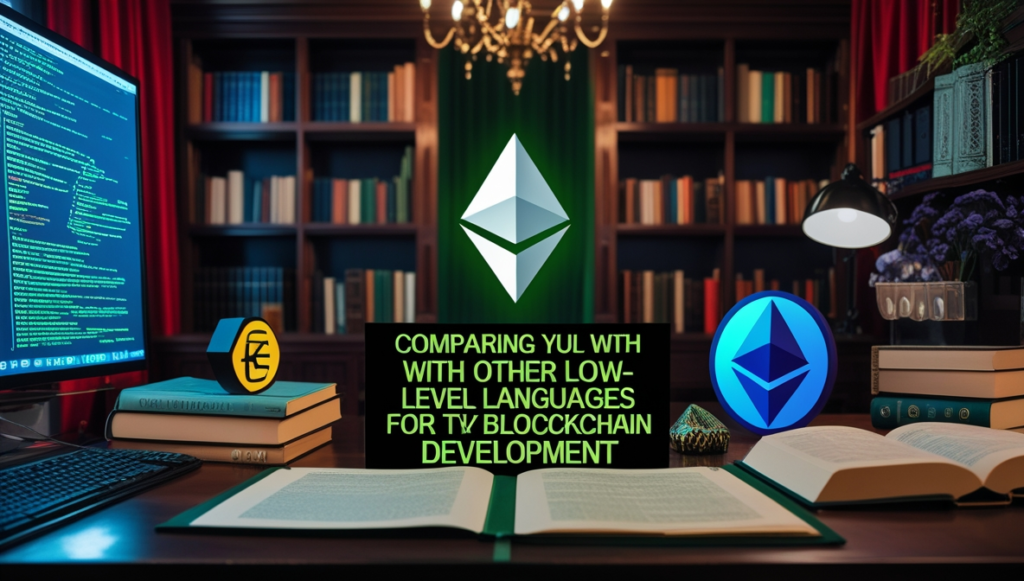Exploring Yul Programming : The blockchain ecosystem has been revolutionizing industries for years now, and at the heart of this innovation lies Ethereum. While Solidity often gets the spotlight as the go-to programming language for Ethereum smart contracts, its low-level counterpart, Yul, is equally powerful. In this chapter, we’ll explore the future of Yul programming, its role in Ethereum’s ecosystem, and how it’s shaping the next generation of blockchain development.
Table of Contents
Exploring Yul Programming?

Yul is an intermediate, low-level language designed for Ethereum developers who require more control over the Ethereum Virtual Machine (EVM). It serves as a bridge between high-level languages like Solidity and the underlying EVM bytecode, making it a preferred choice for optimizing smart contracts.
While Solidity is designed for high-level contract logic, Yul programming is used to create highly efficient and gas-optimized contracts. Developers use Yul to fine-tune operations, optimize loops, and access low-level features of the EVM directly.
Why Use Yul?
- Gas Optimization: Yul programming allows developers to write extremely efficient code, saving gas fees.
- Flexibility: It provides greater control over the EVM, enabling custom implementations not possible with Solidity alone.
- Compatibility: Yul can be used as a standalone language or integrated within Solidity contracts.
If you’re new to Yul programming, think of it as an advanced tool in your Ethereum development toolkit. With a solid grasp of Solidity, diving into Yul can elevate your skills and help you build more efficient blockchain solutions.
Exploring the Future of Yul Programming

The future of Yul programming is tied closely to the evolution of Ethereum and its scaling solutions. Here’s a deep dive into what lies ahead:
Yul+ and Its Enhancements Over Yul
Yul+ is an extension of Yul that builds on its foundation to offer additional features and usability. While Yul focuses on providing a minimal, efficient language, Yul+ enhances its capabilities, making it even more developer-friendly.
Key Enhancements in Yul+:
- Error Handling: Yul+ introduces structured error handling, which is absent in basic Yul.
- Inline Assembly Improvements: It makes writing and debugging inline assembly easier and more robust.
- Enhanced Syntax: Yul+ adds more intuitive syntax for developers, reducing the learning curve.
By adopting Yul+, developers can achieve the same level of gas optimization as Yul while enjoying a smoother coding experience. This makes it an excellent choice for developers looking to optimize their smart contracts without sacrificing readability.
Role of Yul in Advanced Ethereum Frameworks
As Ethereum evolves, frameworks like zkEVMs (zero-knowledge Ethereum Virtual Machines) are becoming increasingly important. Yul plays a critical role in these frameworks due to its low-level nature and compatibility with EVM.
zkEVM and Yul
Zero-knowledge proofs (ZKPs) are essential for scaling Ethereum while maintaining privacy. zkEVM frameworks use Yul for:
- Efficient Circuit Generation: Yul’s low-level control allows developers to generate efficient cryptographic circuits.
- Gas Optimization: In zkEVMs, gas savings are crucial, and Yul helps achieve this by minimizing overhead.
By integrating Yul into zkEVM frameworks, developers can build scalable and privacy-focused applications, setting the stage for the next wave of Ethereum innovation.
Comparing Yul with Other Low-Level Languages for Blockchain Development

When it comes to low-level blockchain programming, Yul isn’t the only option. Let’s compare it with some other languages:
Yul vs. Vyper
- Purpose: While Yul focuses on low-level optimization, Vyper is a high-level language designed for simplicity and security.
- Use Case: Yul is ideal for advanced developers optimizing performance, while Vyper is more suited for secure, straightforward contracts.
Yul vs. Assembly
- Readability: Yul is easier to read and write compared to raw EVM assembly.
- Efficiency: Both are equally efficient, but Yul provides better tooling and debugging support.
Yul vs. Rust (in Substrate)
- Platform: Yul is specific to Ethereum, while Rust is widely used in Substrate-based blockchains.
- Learning Curve: Yul has a steeper learning curve for Ethereum-specific optimizations, while Rust offers broader applicability.
For Ethereum developers, Yul remains a top choice for low-level programming due to its tight integration with the EVM and support within the Solidity ecosystem.
Future of Yul and Advanced Research Topics

The Ethereum community is actively exploring new advancements in Yul and the broader EVM ecosystem. Here are some key research areas:
Upcoming Advancements in Yul and EVM Development
- Improved Compilers: Research is ongoing to make Yul compilers more efficient, reducing gas costs further.
- Tooling and Debugging: Enhanced debugging tools are being developed to make Yul programming more accessible.
- Integration with Layer 2 Solutions: Yul’s role in Layer 2 scalability solutions, like Optimistic Rollups and zkRollups, is expanding.
Exploring Yul+ Language and Its Improvements
Yul+ continues to gain traction as a more robust version of Yul. Research is focused on:
- Security Enhancements: Adding more secure coding patterns.
- Developer Experience: Streamlining the workflow for integrating Yul+ into Solidity projects.
Layer 2 Scalability Considerations with Yul
Layer 2 solutions aim to scale Ethereum without compromising security. Yul is critical for optimizing Layer 2 interactions by:
- Minimizing Gas Costs: Writing efficient transaction logic.
- Enhancing Cross-Layer Compatibility: Ensuring seamless interactions between Layer 1 and Layer 2.
Research on zkEVM and Its Interaction with Yul

zkEVMs are at the forefront of Ethereum’s scaling roadmap. Yul programming is pivotal in:
- Optimizing ZKP Generation: Yul enables the creation of compact, efficient zero-knowledge proofs.
- Improving Execution Speed: By minimizing overhead, Yul ensures that zkEVMs operate at peak efficiency.
- Facilitating Privacy: Yul’s low-level control allows for customized implementations that prioritize user privacy.
The combination of Yul and zkEVMs represents a significant leap forward for Ethereum, unlocking new possibilities for scalable and private decentralized applications.
How to Get Started with Yul Programming
If you’re a beginner, don’t worry—Yul may be advanced, but it’s not impossible to learn. Here’s how you can start:
- Understand Solidity: Familiarize yourself with Solidity, as it’s the foundation for Ethereum smart contracts.
- Study Yul Documentation: Dive into the official Yul documentation to understand its syntax and features.
- Practice Yul Programming Examples: Work on small projects to get hands-on experience.
- Explore Yul Assembly: Learn how Yul interacts with EVM assembly for low-level operations.
- Experiment with Yul+ Programming: Once you’re comfortable with Yul, try Yul+ for enhanced functionality.
Conclusion
Yul programming is an exciting and challenging field with immense potential. Whether you’re optimizing gas fees, exploring zkEVM frameworks, or diving into Layer 2 solutions, Yul opens doors to advanced blockchain development. As Ethereum continues to evolve, Yul and its derivatives, like Yul+, will remain at the forefront of innovation.
For developers passionate about pushing the boundaries of blockchain technology, mastering Yul is a step toward building the future of decentralized applications. With its unique blend of efficiency, flexibility, and scalability, Yul is set to shape the next generation of Ethereum development.
Start your journey today and become part of the thriving Ethereum developer community. The future of blockchain is in your hands!


